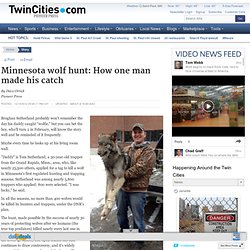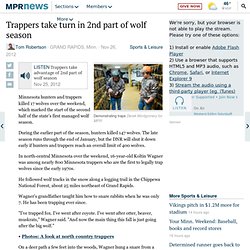

Residents discover coyote badly injured by cruel neck snare. Residents discover coyote badly injured by cruel neck snare (TORONTO: April 16, 2013) – Late yesterday afternoon Toronto Wildlife Centre’s hotline received a call from a Pickering resident.

She had been walking her dog on a path regularly used by locals when she noticed an animal struggling under some trees. At first thinking it was a dog, when she approached she realized it was a coyote. It was caught in wire, injured and looked like it might be dead. TWC’s rescue team responded and were able to contain the coyote, who was still alive. When the coyote arrived at TWC’s wildlife veterinary hospital, it was still in shock. Although staff were unsure the coyote would survive the night, he is stable and alert this morning, and able to sit up on his own. Shortly, the Centre’s head vet, Dr. “Regardless of one’s opinion of coyotes, this kind of action is nothing but cruel and inhumane,” said Nathalie Karvonen, Executive Director.
Nathalie Karvonen, Executive Director Facebook Twitter: @TWC_wildlife.
Trapping coyotes is a tricky challenge. When a Minnesota coyote takes its final, fatal misstep into a snare or foot trap, its traveling days are over. But its coat, its luxurious pelt, the reason the trap was set, will log many hundreds, even thousands, of miles before it rests atop a head or around the neck of a biped. Along the way, the coyote’s skin will be scraped, stretched, dried, bought and sold several times, tanned and cut into strips to be sewn onto a jacket collar or into a hat.
The most difficult step in the process is the first one: trapping a coyote. Veteran Minnesota trapper Andy Shoemaker reports, “They are without a doubt the most intelligent of the dozen or so furbearers I trap. Make one mistake, like leave a tiny corner of a trap uncovered by sifted dirt, they’ll notice it and be 20 times harder to fool the next time.” When a coyote is caught, the next step depends on the time and talent the trapper has to invest in the pelt.
But putting a pelt into the raw state is a time-consuming task. Coyote market. Montana, Idaho trappers catching more than just wolves. In the first year that wolf trapping was allowed in Idaho, trappers captured a total of 123 wolves.

But according to a survey by the Idaho Fish and Wildlife Department, those same trappers in 2011-2012 also inadvertently captured 147 other animals, including white-tailed deer, elk, moose, mountain lions, skunks and ravens. Trappers reported that 69 of those animals died as a result. Montana Fish, Wildlife and Parks wildlife management chief George Pauley said his office is currently gathering similar information about the state’s first wolf trapping season. He doesn’t expect the numbers of non-targeted species to be anywhere near that high in Montana. The difference may center on the use of snares. Idaho allows trappers to use wire snares that collapse around an animal’s neck as it struggles to free itself. Montana officials have considered snares for wolf trapping, but so far have opted not to allow the use of that method, Pauley said. A similar course was taught this year in Montana.
7_trapping_harvest. Minnesota wolf hunt: How one man made his catch. By Dave OrrickPioneer Press Posted: 12/15/2012 05:45:17 PM CST | Updated: about a year ago Thomas Sutherland with a wolf he trapped in the Grand Rapids, Minn., area on Tuesday, Dec. 11, 2012.

(Photo courtesy of Thomas Sutherland) Broghan Sutherland probably won't remember the day his daddy caught "wolfie," but you can bet the boy, who'll turn 2 in February, will know the story well and be reminded of it frequently. Maybe every time he looks up at his living room wall.
Trappers take turn in 2nd part of wolf season. Listen Trappers take advantage of 2nd part of wolf season Nov 25, 2012 Minnesota hunters and trappers killed 17 wolves over the weekend, which marked the start of the second half of the state's first managed wolf season.

During the earlier part of the season, hunters killed 147 wolves. The late season runs through the end of January, but the DNR will shut it down early if hunters and trappers reach an overall limit of 400 wolves. In north-central Minnesota over the weekend, 16-year-old Koltin Wagner was among nearly 800 Minnesota trappers who are the first to legally trap wolves since the early 1970s. He followed wolf tracks in the snow along a logging trail in the Chippewa National Forest, about 25 miles northeast of Grand Rapids. Wagner's grandfather taught him how to snare rabbits when he was only 7. "I've trapped fox. . • Photos: A look at north country trappers.